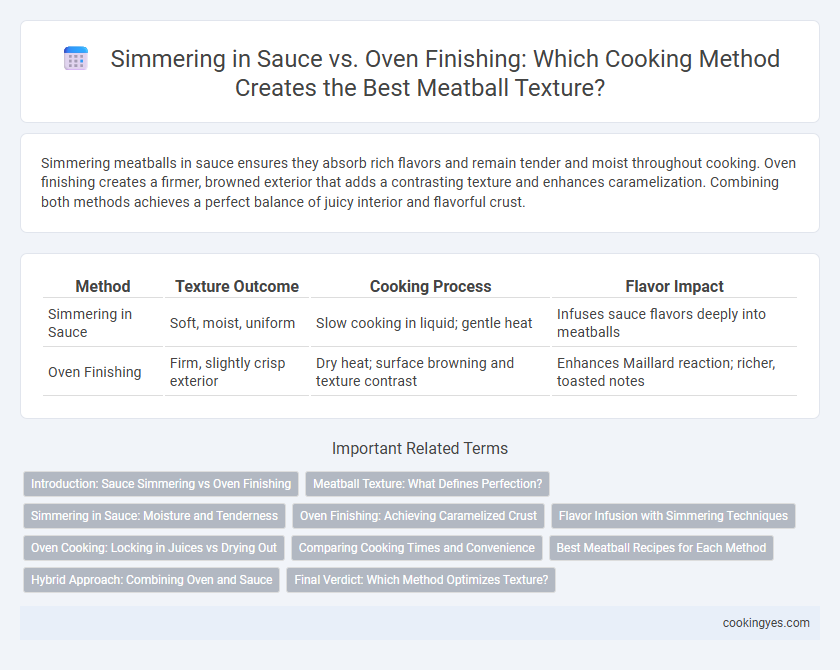Simmering meatballs in sauce ensures they absorb rich flavors and remain tender and moist throughout cooking. Oven finishing creates a firmer, browned exterior that adds a contrasting texture and enhances caramelization. Combining both methods achieves a perfect balance of juicy interior and flavorful crust.
Table of Comparison
| Method | Texture Outcome | Cooking Process | Flavor Impact |
|---|---|---|---|
| Simmering in Sauce | Soft, moist, uniform | Slow cooking in liquid; gentle heat | Infuses sauce flavors deeply into meatballs |
| Oven Finishing | Firm, slightly crisp exterior | Dry heat; surface browning and texture contrast | Enhances Maillard reaction; richer, toasted notes |
Introduction: Sauce Simmering vs Oven Finishing
Simmering meatballs in sauce ensures they absorb moisture and flavors, resulting in tender, juicy texture throughout. Oven finishing creates a firmer exterior and slightly crisp crust, enhancing overall texture contrast. Choosing between these methods depends on desired meatball consistency and flavor infusion.
Meatball Texture: What Defines Perfection?
Simmering meatballs in sauce ensures a tender, moist texture as the gentle heat allows gradual cooking, preserving juiciness and infusing flavor. Oven finishing creates a firmer, slightly crispy exterior while maintaining a soft interior by applying dry heat, ideal for a balanced texture contrast. Perfect meatball texture depends on achieving a harmonious balance between tender inside and a textured outside, tailored by cooking method and sauce composition.
Simmering in Sauce: Moisture and Tenderness
Simmering meatballs in sauce preserves moisture by slowly cooking them at a low temperature, ensuring a tender and juicy texture. The gentle heat allows flavors to meld while preventing the exterior from becoming tough compared to oven finishing. This method enhances the meat's natural succulence, resulting in a consistently soft bite throughout.
Oven Finishing: Achieving Caramelized Crust
Oven finishing meatballs creates a caramelized crust that enhances texture by adding a crispy outer layer while retaining juiciness inside. The dry heat of the oven promotes Maillard reactions, developing rich, complex flavors and a visually appealing golden-brown surface. This method contrasts with simmering in sauce, which results in softer, more uniformly cooked meat without the distinct crust.
Flavor Infusion with Simmering Techniques
Simmering meatballs in sauce allows deep flavor infusion as the slow cooking process enables the meat to absorb aromatic herbs, spices, and tomato base, enhancing overall taste complexity. The gentle heat breaks down collagen, resulting in tender, juicy meatballs with a rich, well-integrated flavor profile. Compared to oven finishing, simmering ensures that every bite is saturated with the sauce's savory essence, creating a more cohesive and flavorful dish.
Oven Cooking: Locking in Juices vs Drying Out
Oven finishing meatballs helps lock in juices by creating a consistent, high heat environment that seals the exterior quickly, preserving internal moisture and tenderness. However, prolonged baking without proper temperature control can dry out the meatballs, leading to a tougher texture. Using a moderate oven temperature and timing carefully balances moisture retention and optimal browning for a juicier, well-textured meatball.
Comparing Cooking Times and Convenience
Simmering meatballs in sauce typically requires 30 to 40 minutes, allowing flavors to meld and produce a tender, moist texture, while oven finishing usually takes 20 to 25 minutes and yields a firmer, crispier exterior. Simmering offers convenience with a one-pot method that combines cooking and flavor infusion, whereas oven finishing demands monitoring and separate sauce preparation. Choosing between these methods depends on the desired texture and available cooking time, with simmering favored for rich moisture and oven finishing for a quicker, textured bite.
Best Meatball Recipes for Each Method
Simmering meatballs in sauce ensures a tender, moist texture as the slow cooking allows flavors to meld and the meat to stay juicy, ideal for classic Italian dishes like spaghetti and meatballs. Oven finishing creates a firmer, browned exterior with a slightly crisp crust, perfect for recipes that require meatballs to maintain shape and texture, such as Swedish meatballs or baked meatball subs. Choosing the best recipe depends on desired texture and flavor infusion, with simmering favoring softness and oven finishing enhancing caramelization and structure.
Hybrid Approach: Combining Oven and Sauce
Simmering meatballs in sauce ensures even cooking and infuses them with rich flavors, while oven finishing creates a desirable crispy exterior and firmer texture. A hybrid approach first simmers the meatballs gently in sauce to maintain juiciness, then transfers them to the oven to develop a golden crust, balancing tenderness and texture. This method optimizes flavor absorption and texture contrast, enhancing the overall meatball experience.
Final Verdict: Which Method Optimizes Texture?
Simmering meatballs in sauce allows them to absorb moisture and flavors, resulting in a tender and juicy texture that is uniformly soft. Oven finishing creates a firmer exterior with a slight crust, enhancing texture contrast but potentially drying the interior if overcooked. For optimizing overall meatball texture, combining initial searing or baking with a final gentle simmer in sauce offers the best balance of a flavorful crust and moist, tender inside.
Simmering in Sauce vs Oven Finishing for Meatball Texture Infographic

 cookingyes.com
cookingyes.com